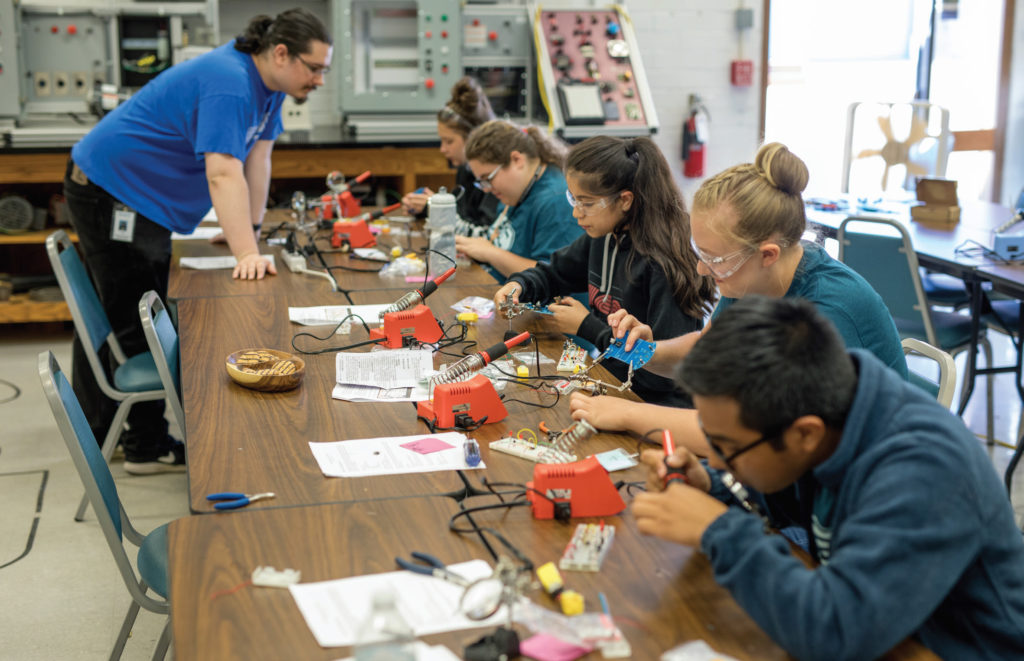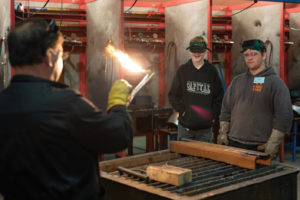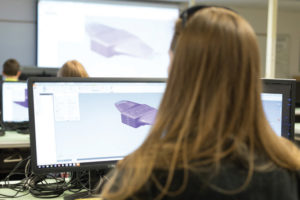The Pipeline to Jobs Project

Students practice soldering skills in a Pipeline to Jobs class designed to teach skills that can lead to good jobs at area industries.
Pipeline to Jobs Project Program creates a path to career jobs without a four-year college degree
Published in the Ruralite Magazine Oct 2017 – By Craig Reed
A partnership of business, education, local government and the Albany Area Chamber of Commerce is turning students into skilled workers. Three years ago, that partnership in Linn County created the Pipeline to Jobs Project, with a mission “to help students, employers and educators discover a path that puts young people on the most direct line from school to a rewarding job with a bright future.” The intent is to increase the workforce with young, skilled people who can fill job vacancies at multiple manufacturing, industrial and healthcare businesses in Benton and Linn counties.
“Across the country, we’ve seen a shortage of qualified employees for manufacturing,” says Janet Steele, president of the Albany Area Chamber of Commerce. “If we’re not building our own workforce, those work opportunities will go to other places. “We’re greatly appreciative of the local industries, the businesses, Linn-Benton Community College, the school districts, the city of Albany, and Linn and Benton counties that have helped us grow our own local workforce.” The project makes students, parents, and educators more aware of job opportunities in the area. Greg Hamann, President of Linn-Benton Community College, says the project is proving to be successful. Prior to Pipeline, a summer camp that provided baseline information and preparation for manufacturing jobs was only about one-third full. With increasing awareness and demand, two camps were held last summer. Both were full, and there was a waiting list.

Welding skills are in high demand. The Pipeline to Jobs Project offers welding classes specific to area welding needs.
At LBCC, new classes have been created and additional classes added for some subjects in the last couple of years. There are waiting lists for those classes. Dave Becker, the dean of Industrial Technology programs at LBCC, agrees that Pipeline is succeeding. He says 88 percent of the students coming out of the school’s welding classes are getting jobs fairly quickly. Some jobs were offered well before graduation. Five students received offers during the fall term, and more offers followed during winter and spring terms. “The need for workers in the industrial trades is so great,” Dave says. “These are livable wage jobs, $40,000 to $45,000 for a beginner welder. I’ve said this all along, there’s a major return on this investment.” Greg admits education and business have not always communicated effectively, but that changed with the Pipeline concept. “The Pipeline grew out of an awareness of that fact,” he says.
History—Establishing the Pipeline
The idea for the Pipeline was conceived at a 12-On-12 luncheon—a gathering coordinated by the Albany Area Chamber of Commerce that includes representatives from 12 area companies and businesses. As the conversation went around the table, a common issue was the lack of workers with the specific skills needed by the businesses. In addition, there was concern about the future as it was being forecasted that even more workers would be needed because of retirements by baby boomer employees and anticipated business growth. “Workforce development is a big deal for all of us,” says Rick Kenyon, president, and CEO of Selmet Inc., a company that casts titanium parts for the aerospace and defense industries. “It’s easy to complain about something. We can complain or we can do something about it.
“We felt if we all worked together, we could come up with something, get the message out that there are family-wage jobs out there,” he says. “Rather than waiting for something to happen, we could make it happen.” Jim Merryman, president of Oregon Freeze Dried Foods, was at that Albany luncheon. He heard what Rick heard. “We were all saying the same thing,” Jim recalls. “We were all moaning and groaning about workforce development, the lack of skilled employees. When it got to me, I said we better look in the mirror and ask ourselves, ‘what are we doing to fix the problem?’ Rather than complaining about it every day, what can we do?” Major companies in the area decided to step up and fund a program. Those included Selmet, Oregon Freeze Dried, ATI Wah Chang (Allegheny Technologies Inc.), Viper Northwest, Samaritan Health Services and Entek.
Through the Albany Area Chamber of Commerce, a Workforce Development Taskforce was convened. The task force discussed the needs of local business and industry and developed a plan to combine its efforts with local educators to provide more comprehensive training options for local students. Pipeline provided a single source of information and opportunity for students, educators, parents, and industry. The task force discovered the emphasis by the local educational system was on preparing students to attend colleges and universities to pursue four-year degrees. Many of the job opportunities in question needed only a two-year technical or science degree. “We need workers coming to us who are ready for the job,” Jim says. “The schools needed to understand what we needed in our businesses.”
Developing the Pipeline
Funds provided by the companies made it possible to hire Josefine Fleetwood as the Workforce Development director. She and Chamber President Janet Steele worked together to reach out to Linn-Benton Community College, to the public schools in the greater Albany area, to the city of Albany and to Linn County. “We needed a more formalized program and we needed a person to oversee it,” Janet says. “Industry had come to the chamber and said we’re going to pay the way.” Welding skills are in high demand. The Pipeline to Jobs Project offers welding classes specific to area welding needs.
Those contacted quickly became advocates and supporters of the Pipeline idea. Officials from LBCC and the chamber visited the companies and interviewed workers on the production floor about their jobs and the skills needed to do them.
LBCC reviewed its curriculum, adapting some classes and adding new classes to provide education for those skills. “We realized quickly we needed to be a part of this effort,” says Greg. “First of all, we needed to better understand their needs and then we needed to modify our programs to meet those needs. “Our programs had not been aligned with their needs. We didn’t talk and we didn’t know we were missing the mark. After we went on the production floors to better understand what the workers did, we changed our programs.” The city of Albany gave LBCC $2.8 million to help improve and update the school’s equipment and career technical education program. Other stakeholders donated funds to the Pipeline. Greg says middle and high school students and teachers also needed to be made aware of the job opportunities that were available. Jim Golden, the superintendent of the Greater Albany Public Schools, says teachers and members of the Albany Chamber worked together to arrange tours of local businesses, and to reach out to families to educate them about the many employment opportunities that exist in industries in the greater Albany area. Students, parents, and educators from area schools saw job opportunities up close.
“The mission of the Pipeline Project is to prepare our students to enter into the workforce with the desired soft and hard skills necessary for them to successfully work in our Greater Albany business community,” Jim says. “The idea is that we will expose kids to employment options in our industries that need highly skilled labor and our willingness to train workers with these skills.” Summer camps were scheduled to give kids a chance to learn some of those skills at a basic level. Those camps are proving successful. “We know that 70 percent of high schoolers don’t go on to four-year degrees,” Janet says. “Their parents, the community, the educators all need to be made aware of the path to jobs in these industries—the pipeline to get there.” The response to the Pipeline in the Albany area led to the Pipeline concept being used in East Linn County.
The Productive Pipeline
“It’s been an absolute team approach,” says Rick. “There were no exceptions. Any of us involved in this from the ground floor are happy with what we’ve put together. This program has been a resounding success.” By 2014, Pipeline’s first year, there were 50 students in the Career Technical Education classes at LBCC. During the 2016-17 school year, 150 students were enrolled. Janet says at the CTE signing day at LBCC last spring, 75 students from Linn and Benton counties signed up to attend classes. Students who sign up early are guaranteed a seat. “We’re starting to see results, not only with kids attending LBCC but some hiring of LBCC graduates,” Janet says.
Josefine says the information and exposure to local companies have helped kids make more informed decisions about their futures. “We have inspired students, young kids, to look ahead,” she says. As part of the Pipeline project, Jim Golden says South Albany High School created an Employability Grade where middle school and older students are encouraged to think about post-high school opportunities that not only include college or community college but immediate employment in good jobs with growth potential for a career. Lebanon High School has adopted that concept. “We are committed to working with our community partners in the chamber and in business, in general, to ensure that our community is an attractive place for both workers and business,” Jim Golden says.
Jim Merryman says the Pipeline taskforce projected three years ago that the area’s manufacturing, industrial and health industries would need another 1,000 employees over the next five years due to business growth and employee retirements. He says that projection is proving to be true. Jim emphasizes skills used in working for these companies are the key to earning higher wages.
“The more skill sets they pick up and learn, the more money I will trade for them,” he says.“Too many times we depend on the government to solve our problems, and the government doesn’t have a good track record of actually solving those problems. Therefore, we needed to step up and solve the problem ourselves. That is what is going on here.”
More companies have become partners in the Pipeline in the last couple of years. Stakeholders are committed to funding the project at least three more years. “We are starting to see results,” Janet says. “We’re not only seeing more students enrolled in these classes at LBCC to learn the needed skills, but we’re also seeing some hirings by the business partners.”


